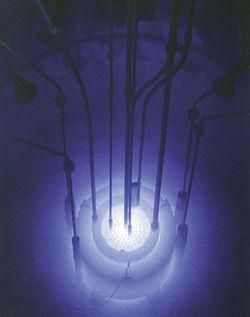The Reactor is Going Critical!

You hear that phrase a lot. Let's look at what it actually means, and you'll never be able to watch sci-fi movies again. It's also worth pointing out that nuclear reactors actually look really boring. Kind of like a pressure cooker with tubes coming out of the top and sides. Not very good sci-fi visuals, trust me.
Reactivity is defined as the amount by which the reactor has departed from criticality.
Sounds fancy, yeah? Alright, let's break that down.
Criticality is the state of a nuclear reactor core when the current generation of neutron flux is the same as the previous generation. In simple terms, it means that the power level is steady. In mathematical terms, your time derivative of flux is zero. Remember that this term is only used when the reactor is self-sustaining. That means that no control rod motion is required to keep it from dipping into subcriticality.
Reactivity can be changed by a few different things. When discussing a reactor core, you often speak about the reactivity coefficient.
The first reactivity coefficient I will discuss is the fuel coefficient of reactivity. This is also sometimes called the Doppler coefficient. This describes the change in reactivity due to the change in the temperature of the fuel. As the fuel heats up, the molecules expand outward as they become more energetic. Because of this expansion, the macroscopic cross-section of neutron absorption becomes smaller.
What??
That means that the fuel is less likely to absorb a neutron as there is a larger chance for the neutron to pass through the material without striking anything. As a result, the fast and thermal non-leakage factors for the neutron generational lifetime are smaller.

Similar to the Doppler coefficient, the temperature coefficient of reactivity for the moderator exists. This works in the exact same way as the fuel coefficient of reactivity, however, it applies to the moderator. This typically has a much larger effect on reactor power levels for a given change in temperature. The temperature coefficient of reactivity is important because it stabilizes reactor power following a change in the overall steam load of the turbine. If the temperature coefficient of reactivity is positive, the system will be inherently unstable.
The reactor plant heating up will cause the reactor power levels to rise to cause more heat production and a subsequent further rise in power levels. This reactor will require a constant balancing act of adjusting other forms of reactivity (such as control rods or soluble boron levels) to compensate for temperature changes. If the temperature coefficient of reactivity is negative, a temperature rise will cause power levels to lower such that there will be a mismatch between the thermal output of the reactor and the thermal demand of the system. This will cause the temperature to lower to its original value. The magnitude of the temperature coefficient of reactivity determines the speed at which this transient will occur. Too low in the magnitude of the number and the reactor plant will respond sluggishly to any transient. If the magnitude is too high, operator action may not be fast enough to prevent adverse effects of an undesired reactor plant transient.
Another coefficient of reactivity to discuss is the pressure coefficient of reactivity. This accounts for the change in the density of the moderator in the reactor core due to the compressive effects of being pressurized. Another way to think of it is the ratio of the moderator to fuel in the core. This is generally insignificant from an operational standpoint; however, it must be accounted for from a design standpoint.
The final coefficient of reactivity to discuss is also the most famous: the void coefficient of reactivity. This is the change in reactivity due to the formation of voids within the core. In a positive void coefficient, the coolant acts as a neutron absorber. If the coolant boils, voids form within the coolant stream. Because of this, fewer neutrons are absorbed, and reactor power levels rise. This can cause a dangerous positive feedback loop since more thermal energy is being produced. This is a famous concept because it is one of the major contributing factors to the Chornobyl disaster.
A zero void coefficient would be any system that does not use liquid coolant. This would primarily describe a gas-cooled reactor where voids are already present. A negative void coefficient is the most common type. This is where voiding of the coolant will cause fewer neutrons to be thermalized. In a pressurized water reactor, this is a useful safety function. In a boiling water reactor, this can serve as a method for causing a reactor shutdown. Since boiling water reactors operate near saturation conditions, any increase in pressure will cause significantly less boiling. Due to the negative void coefficient, reactor power levels will rise. Since commercial power plants operate at as close to a 100% power level at all times, an unexpected turbine trip (and subsequent root valve tripping shut) can cause a reactor power excursion leading to a reactor SCRAM.
Check out some other pages here to read more about how a nuclear power plant works!





Member discussion